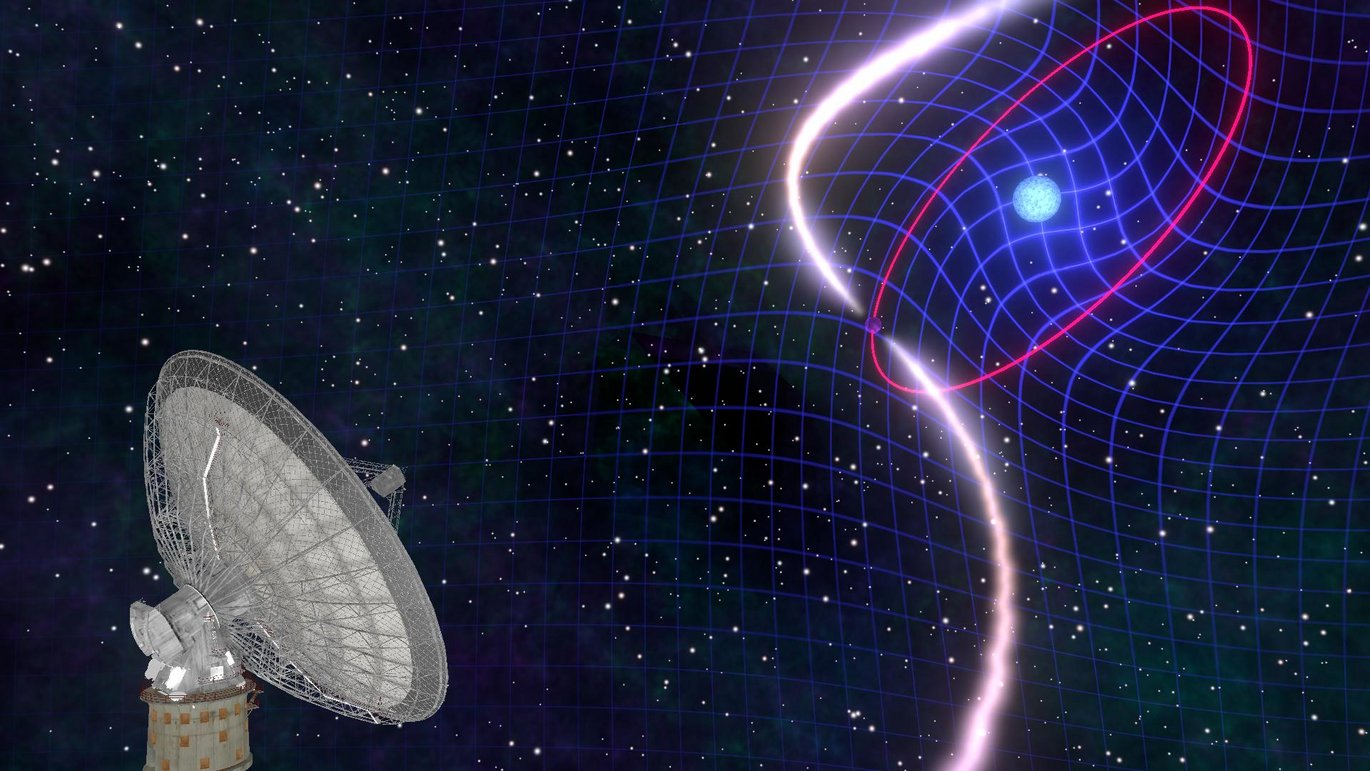Space-time is dragged around
Astrophysicist and AIAS fellow Thomas Tauris contributes to our understanding of how dead stars impact gravitational forces. Hereby we are one step closer to understanding the forces of nature. The results have been published in the scientific journal 'Science'.

Humans have always been obsessed with understanding the forces of nature, as Danish physicist and chemist H. C. Ørsted was 200 years ago when he discovered electromagnetism, or as Einstein was about 100 years ago, when he changed our perception of gravity.
Gravity is probably the one of the four known forces of nature that is most difficult to describe scientifically. Our current understanding of gravity is based on Einstein’s geometric interpretation, the general theory of relativity, proposed in 1915. Unfortunately, Einstein’s theory has the shortcoming that it is incompatible with quantum physics. To combine these two theories is one of the greatest goals for modern physics. The key to this combination requires investigations under extreme conditions.
The strongest gravitational forces are found around compact objects such as black holes, neutron stars and white dwarfs, which are the stellar remnants of dead stars. It is well known that these extreme objects bend space-time, so that, for instance, light is bend in its trajectory around these objects.
But this is not all that happens. If such compact objects are rotating, they will drag space-time with them. This phenomenon is called frame dragging, a theory originally proposed by Austrian physicists Lense and Thirring in 1918. Frame dragging will, among other things, have the effect that a nearby rotating object will spin around like a top ̶ which means that it’s spin axis is wobbling (precessing) during movement.
Danish astrophysicist Thomas Tauris, who is a professor at Aarhus University at the Aarhus Institute of Advanced Studies and the Department of Physics and Astronomy, has now contributed with significant calculations for a new study of these effects, that was published on 31 January in the prestigious scientific journal Science.
Frame dragging in a binary star system
Thomas Tauris has carried out the study together with an international team of astrophysicists from Germany, Australia and Denmark, under the management of Dr Vivek Venkatraman Krishnan (Max Planck Institute for Radio Astronomy in Bonn). The team has specifically studied the effects of frame dragging in a binary star system, where a radio pulsar (a fast rotating neutron star with a strong magnetic field) is in close orbit of a white dwarf. It is the first time that this phenomenon has been proved in such a system.
“The detection of frame dragging is possible, because the periodic signals from the rotation of the radio pulsar can be measured with very high precision in its 5-hour orbit around the white dwarf. So what we can now reveal is the effect (the so-called Lense-Thirring effect) of space-time being whirled around due to the rotation of the white dwarf”, said Professor Thomas Tauris.
70 million supernovae explosions
To interpret the measurements, Thomas Tauris has conducted the theoretical calculations of the rotation of the white dwarf and the inclination of its rotational axis.
“The white dwarf is rotating so fast, because mass has been transferred from its companion star before it exploded in a supernova explosion, and created the radio pulsar that we can observe today. We have calculated the mass transfer in detail as well as the effect of the supernova explosion from 70 million simulations”, elaborated Thomas Tauris.
Video animation: Mark Myers/ARC Centre of Excellence for Gravitational Wave Discovery (OzGrav).
This discovery, along with several other fascinating phenomena, will be discussed extensively in the month of May when the Aarhus Institute of Advanced Studies (AIAS) at Aarhus University is hosting a large international conference on exactly neutron stars.
More details on the white dwarf J1141-6545
The white dwarf J1141-6545 is rotating very fast, with a rotation period of about 100 seconds. This causes frame dragging with such an effect that corresponds to a coordinate system placed on its north pole will rotate by 16 degrees in the course of 24 hours. In comparison, frame dragging in an equivalent coordinate system caused by the Earth’s rotation will result in a rotation of 16 degrees in the course of 270,000 years – so with an effect which is 100 million times smaller. The big difference in effect happens because the white dwarf is much heavier and rotates significantly faster than the Earth.
Scientific article
”Lense-Thirring frame-dragging induced by a fast rotating white dwarf in a binary pulsar system” by V. Venkatraman Krishnan, M. Bailes, W. van Straten, N. Wex, P.C.C. Freire, E.F. Keane, T.M. Tauris, P.A. Rosado, N.D.R. Bhat, C. Flynn, A. Jameson, S. Osłowski in: Science, 31 January 2020.
Popular scientific articles on the results
Popular science article on Videnskab.dk (in Danish): https://videnskab.dk/naturvidenskab/igen-har-einstein-ret-hvid-dvaerg-rykker-rumtiden-rundt
Popular science article in Scientific American (in English):
https://www.scientificamerican.com/article/bizarre-cosmic-dance-offers-fresh-test-for-general-relativity/
Neutron star conference, AIAS, 11-15 May 2020: https://aias.au.dk/events/nordic-neutron-stars/
Thomas Tauris’ website: https://tildeweb.au.dk/au77884/
Contact
Professor Thomas Tauris, AIAS Fellow
tauris@aias.au.dk
Phone: +45 87153682
Aarhus Institute of Advanced Studies (AIAS) and
Department of Physics and Astronomy
Aarhus University
Høegh-Guldbergs Gade 6B
DK-8000 Aarhus C
Denmark
